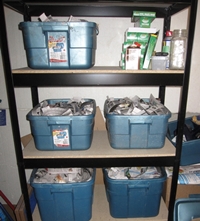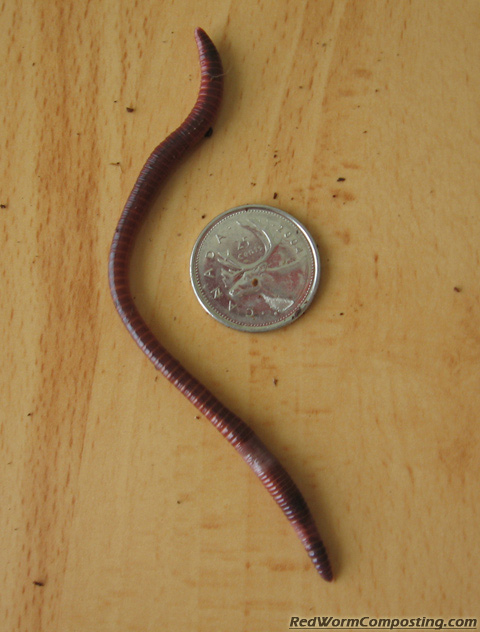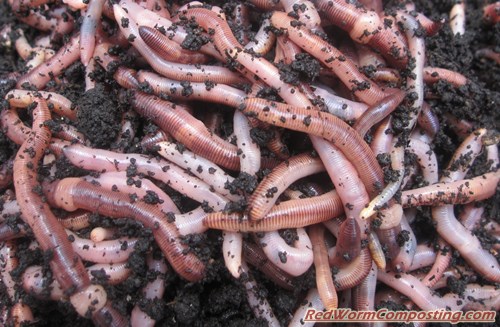Worms
Mystery Composting Worms

Over the past few years I’ve started noticing a smaller worm consistently showing up in my (mainly outdoor) vermicomposting systems.
It has always been relatively easy to spot, and tell apart from my Red Worms. Aside from the smaller size, it has a pale body coloration, with a pronounced, creamy-yellow clitellum (obvious in worms that would be too small to be mature Reds). It has usually seemed quite inactive, regularly exibiting a funny “frozen”, curved appearance.
I never reallty found a lot of them at once. All in all, it seemed clear to me that they weren’t nearly as prolific – nor did they demonstrate remotely as much composting potential – as the Red Worms, so I didn’t give them much thought.
Until early 2020, that is!
😉
For some strange reason (more…)
**For Even More Worm Fun, Sign Up for the RWC E-mail List!**100 lb of Red Worms in a Single Room?

The are various reasons for people wanting to be able to raise lots of composting worms. They can be used to stock more systems (to process even more wastes and produce even more castings); they can be used for large-scale projects; they can be shared with others (helping to “spread the worm”); they can be used as a live food or fishing bait – or they can be sold for profit.
Naturally, if you can raise more worms in less space that’s even better!
Back in the “olden days” of the internet (and modern vermicomposting for that matter) a man by the name of Brian Paley wrote an article called “How To Breed, Raise, and Maintain A 100-Pound Stock of Worms in a Single Room“.
It is a very long article – nearly 14,000 words…basically the equivalent of (more…)
How to Tell Euros Apart From Red Worms

A recent discussion in a Facebook group about distinguishing European Nightcrawlers (Eisenia hortensis; sometimes Dendrobaena sp) from Red Worms (Eisenia fetida/andrei) reminded me that this is something a lot of people wonder about. So I thought I would take some pictures (now that I finally have Euros!) and share what I feel are some of the key differences.
The “big 3” in my mind are:
1) Size
2) Body Shape
3) Coloration/Striping
——————————-
** SIZE **
As you can see in the first image, Euros are typically (more…)
The One Worm Reproduction Conundrum
It takes two to tango, right?
Usually, yes – but this is may not always be the case in the wonderful world of worms.
While earthworms are hermaphroditic – that is to say each worm contains both sexes – this actually doesn’t stop them from mating most of the time. After all, genetic diversity tends to be an advantage for most species over the long-haul. You know…’survival of the fittest’, and all that jazz.
(In other words, if all worms in a population had the exact same genetic make-up, none would better adapted to survive any of the many hazards they can encounter)
Nevertheless (as alluded to earlier), (more…)
European Nightcrawlers – In More Detail
During the past year or so (especially the last 6 months) I’ve had the opportunity to spend a lot more time working with European Nightcrawlers (Eisenia hortensis / Dendrobaena veneta), and as you can probably tell from my writings, I’ve really come to respect them a lot more.
It’s funny to think that my frustrating experience with Euros in my VB48 actually helped lead me down the path to my new found appreciation of these worms. I guess you could say it’s one of those “making lemonade out of lemons” situations that actually panned out (as you may recall, I came up with a skirt-tray system down below the VB48 that’s been working very well).
Spending as much time with these worms as I have, I’ve come to realize that (more…)
Do Euros and Red Worms Get Along?

Small European Nightcrawler (Eisenia hortensis) found in one of my vermicomposting trenches
When you are a professional worm farmer selling multiple species of worms, it can be a real pain when one species invades the bed(s) of another. In fact, a lot of times this can mean that the batch of worms is no longer good for sale. This helps to explain why a lot of worm farmers prefer to stick to one species – and one species ONLY!
Late last fall, my main Red Worm grower (for U.S. orders) decided to start dabbling in Euro growing. Some of you may recall the “Euro Shipping Sale” I held back in January to showcase these smaller-than-usual Euros (not to be confused with the Euros I currently sell here on the site – which come from a completely different, Euro-only worm dealer).
Well, as I recently learned from my supplier, some of the Euro beds at the Red Worm farm have now been invaded by Reds, meaning that the worms can no longer be sold as either Euros or Reds. Rather than giving up on those beds however, he’s decided to now offer mixed batches of worms – at a discount!
I thought this was an interesting “outside the box” approach to what many worm farmers would consider to be a ‘problem’, and have decided to start offering (very soon) these mixed batches for sale here on the site – at least for as long as they are available. (more details about all this in another upcoming post)
Now, this brings us to the topic of this post – a question I get asked a fair amount. In a nutshell…can Red Worms and European Nightcrawlers be kept in the same system?
The short answer is ‘of course!’ – but you know how I feel about ‘short answers’!
😆
Red Worms and European Nightcrawlers are very closely related species of worms (they share the same genus name, after all), but are distinct enough that they cannot reproduce and create ‘hybrid worms’ (sorry folks – that’s a myth!). What’s interesting about this topic is the fact that when people ask if they can keep their Euros and Reds together, I tell them ‘yes’, but normally recommend not doing so.
Part of my rationale behind this advice has to do with the fact that I often tend to think like a worm farmer, and forget that many of my readers are vermicomposting explorers (ie people who simply want to play with worms, reduce their wastes, and grow big plants). As I alluded to above, if you mix these worms together, your chances of easily separating them again are slim to none (again, a situation that can be a real pain if you are a worm seller)!
Difficulties with future separation aside…
The fact that Euros are typically more expensive than Red Worms, coupled with the fact that they usually prefer somewhat different living conditions than Reds, adds some justification to my recommendation to keep them apart.
Also, as I’ve written about in another post, academic research has shown that Euros are typically a ‘slower’ worm, in terms of development, reproduction etc. Here again are some interesting results I shared (from two different sources) previously:
From Edwards (1988)*:
Eisenia fetida
# of viable hatchlings per cocoon – 3.3
Time to Maturity – 85-149 days
Eisenia hortensis
# of viable hatchlings per cocoon – 1.1
Time to Maturity – 97-214 days
From Dominguez (2004)*:
Eisenia fetida
# of viable hatchlings per cocoon – 2.5-3.8
Time to Maturity – 28-30 days
Life cycle – 45-51 days
Hatching viability – 73-80%
Eisenia hortensis
# of viable hatchlings per cocoon – 1.1
Time to Maturity – 65 days
Life cycle – 100-150 days
Hatching viability – 20%
*References listed at end of post
This information seems to suggest that there is some potential for Red Worms to outcompete Euros if they are in the same system – yet another reason to think about keeping them separate. My own (limited) experience with mixed beds, seemed to support this possibility…but as I’ll explain in a minute, I’ve made some intriguing discoveries this year that have made me question my ‘no mixing’ advice.
Let’s first chat about the previous experience. Quite some time ago I wrote about one of my Euro bins going ‘sour’, and how I subsequently added the contents of this bin to my big backyard Red Worm bin. Well, long-story-short, those Euros basically vanished without a trace – I did find one or two when I was harvesting vermicompost from the bin the following spring, but for the most part the system seemed to remain a ‘Red Worm bed’.
In hindsight, there are certainly some possibilities re: what may have happened here. For starters, Euros tend to prefer the deeper zones in a vermicomposting system, where temperatures are often lower, and moisture content is higher. This actually reminds me of the funny experience I had when I tried to introduce Euros to one of my Worm Inns. In that situation, when I couldn’t find any Euros within a matter of days from the time I introduced them, I also felt like they had ‘disappeared’ on me. What I discovered however, was that they were simply congregating down in the lower reaches of the Inn (the irony being that this was actually a drier zone than near the surface).
Something else that’s really important to keep in mind is the fact that most of the worms I found in the vermicompost harvesting zone of my backyard bin (and there were a LOT of them) were teeny tiny! There wouldn’t have been much food value in this material by that point, so the worms ended up getting smaller and smaller. As such, it is perfectly reasonable to guess that some of these little wigglers could just as easily have been Euros (since it becomes more difficult to distinguish these species when they shrink really small).
Moving on to my interesting discoveries from this year…
Last summer/fall I added a batch of worms – that happened to have a few Euros in it – to my sandbox trench. Given my previous experience with adding Euros to Red-Worm-dominated systems, and given the fact that I was literally only adding a handful of them, I was sure that would be the last time I’d see Euros in my outdoor beds (unless I added them again).
Well interestingly enough, this spring and summer I have been finding Euros in my trenches – and not just in the sandbox trench either (although most seem to be in this area). I clearly remember how shocked I was early in the spring when I found a JUMBO Euro in my main trench – believe me, I’ve been kicking myself ever since for not running to get the camera, then writing about it on the blog. Speaking of which, I was actually very happy to get the news about the mixed worms from my supplier, since it reminded me of the fact that I’ve been meaning to write about this topic for quite some time now!
So…the moral of the story (haha), is that I am no longer convinced that keeping Reds and Euros together is ‘bad’ – well, at least not in vermicomposting trenches!
😆
By the way – something else I found really interesting about the Euros in my sandbox garden is that I didn’t find them way down deep – some of them (such as the cute little fella pictured above) are actually doing just fine up in the garden itself, where I added some manure and straw for the benefit of the corn plants growing there.
Anyway, I will certainly be interested to hear what others have to say about mixing these two species of worms! If you do have some experiences to share, please chime in – this could make for a really interesting discussion!
Also, as mentioned above – for anyone who is feeling vermi-adventurous, I will be offering batches (5 lb) of Euro/Red mixes for sale very soon at a discounted price (and will write a post about it on the blog – perhaps even up by the time you are reading this).
**UPDATE: Learn more about the sale here >>> The Euro / Red Worm Mixed Bag Sale**
REFERENCES
Dominguez, J. 2004. State-of-the-art and and new perspectives on vermicomposting research. In: “Earthworm Ecology”. Edwards, C.A. (ed). CRC Press, Boca Raton, pp. 401-424.
Edwards, C.A. 1988. Breakdown of animal, vegetable and industrial organic wastes by earthworms. In: “Earthworms in waste and environmental management”. Edwards, C.A. & Neuhauser, E.F. (eds). SPB Academic Publishing Co, The Hague, pp. 21-31.
Red Wigglers – The Cadillac of Worms

Another busy week on the vermicomposting business front I’m afraid. I’m certainly not complaining, but I really miss being able to write on the blog more often.
Anyway, this isn’t much of a post about anything – just an excuse to get something up for all y’all. One of my customers this week asked me if I was familiar with the funny worm advertising that ran during Johnny Fever’s radio program on ‘WKRP in Cincinnati” (sit-com from early 80’s). The slogan for the company was apparently “Red Wigglers – the Cadillac of Worms”.
I used to watch that show, but the fact that I was a kid at the time and didn’t yet have an interest in Red Worms helps to explain why I don’t have any recollection of that line. Anytime I hear references to composting worms anywhere these days I certainly sit up and listen.
So IS the Red Wiggler really the ‘Cadillac of Worms’?
Well, I guess that up to you to decide. It certainly is an amazing little creature!
In case you are curious, the worm pictured above (out of focus as it is – grrrr) is one of the large Red Worms I found in an aged manure pile. This particular specimen is pretty well the same size as many of my European Nightcrawlers.
Oh, and believe it or not, you can actually get a T-Shirt with the above-mentioned slogan on it. Check them out here: http://www.zazzle.com/krw_red_wigglers_the_cadillac_of_worms_shirt-235494087101854505
Speaking of which – I am actually planning to put together a little online shop for worm t-shirts etc, hopefully in time for the holiday season (so you can surprised your friends a relatives with the ultimate gift – haha). So keep your eyes peeled!
8)


